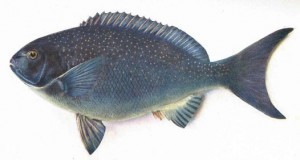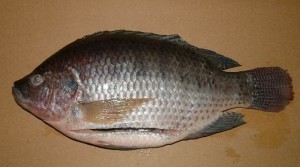What is the Size of a Bluefish?
The size of the bluefish (Pomatomus saltatrix) starts from 7  inches (18 cm) and can grow longer. There are a few bluefish that weigh 40 lbs (18 kg). However it is quite rare to find 20 lb+ (9 kg) bluefish.
inches (18 cm) and can grow longer. There are a few bluefish that weigh 40 lbs (18 kg). However it is quite rare to find 20 lb+ (9 kg) bluefish.
Classification
The bluefish is of the Pomatomus genus in the Pomatomidae family. They are in the Percoidea superfamily. The fish is known as tailor in Australia. It is called shad in South Africa. In other places it is known as the anchoa, chopper or blue.
Physical Characteristics
The fish has a fairly proportioned body. The tail is forked and it has a folded dorsal fin. The pectoral fins are also folded. The fish has a gray, blue-green color which turns to white at the belly and the sides. This coloring pattern holds true regardless of the size of the bluefish. On each jaw is a row of sharp teeth.
Habitat and Distribution
This marine fish is found in virtually all oceans and seas (except the eastern Pacific). The fish is migratory in nature. From the Atlantic, the range goes from Argentina to Nova Scotia. The fish is usually located at the sand bottoms. Some of the fish can be seen at depths of 60 m (200 ft).
Life
Very little is known of its spawning habits. What is understood is that the bluefish larvae are as large as the zooplankton. It has been established that the bluefish population is cyclical. At the North Atlantic, the population is divided along Cape Hatteras. The spawn found here can end up at the mid-Atlantic and off the coasts of New England.
Feeding and Diet
Regardless of the size of the bluefish, their feeding habits have been well established. They like to eat sardines like weakfish, grunts and jacks. Their diet also consists of shrimp, squid and striped anchovies.
The bluefish is known for being very forceful. They have been known to go after baitfish all the way to land. There are also bluefish that will go after bait even in very little water. The bluefish have been known to shred bunker fish.
Bluefish are known for their cannibalistic behavior. Some scientists believe this is the reason why bluefish school with similarly sized specimens. By having the same size the fish will use up the same amount of energy. This also translates to equal food needs.
Natural Predators
The bluefish have many natural enemies throughout their life. When they are young, their predators include fluke (summer flounder), striped bass, tuna, rays, weakfish, sharks dolphins and other bluefish.
When they reach adulthood, their predators become the porpoise, tuna, more dolphins, sea lions, billfish and other larger fish. Humans also like to eat this fish. The best types are the young bluefish. There are many ways to cook the fish, including smoking.
The taste and size of the bluefish has made it very poplar as a commercial fish. In the past its population dwindled. But thanks to proper management the species is slowly being able to recover.





